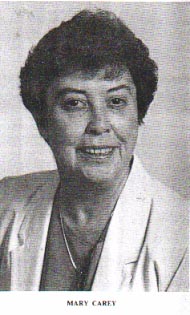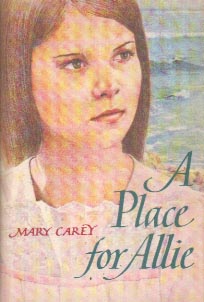THREE INVESTIGATORS
AUTHOR: M.V. CAREY
MARY VIRGINIA CAREY
1925 - 1994
Personal: Born May 19, 1925, in New Brighton, England; brought to the United States in 1925, naturalized citizen in 1955; daughter of John Cornelius (an engineer) and Mary Alice (Hughes) Carey. Home address in 1993 was 3748 Birch St., Ventura, CA.
Education: College of Mount St. Vincent, B.S., 1946.
Religion: Roman Catholic
Career: Coronet, New York City, editorial associate, 1948 - 55; Walt Disney Productions, Burbank, CA, assistant editor of publications, 1955 - 69; free-lance writer 1969 - 1994.
Member: PEN; Mystery Writers of America; Society of Children's Book Writers; Women in Communications.
Awards, Honors: Southern California Council on Literature for Children and Young People Award, 1986, for "A Place for Allie".
Hobbies and Interests: Walking on the beach.
Writings:
Novelizations of Walt Disney Motion Pictures:
(With George Sherman) WD's "Babes in Toyland" Golden Press, 1961.
WD's "The Sword in the Stone" Whitman, 1963.
The Story of Walt Disney's Motion Picture "Mary Poppins" Whitman, 1964.
WD's "The Misadventures of Merlin Jones" Whitman, 1964.
WD's "Donald Duck and the Lost Mesa Ranch" Whitman, 1966.
The Story of WD's Motion Picture "Jungle Book" Whitman, 1967.
The Story of WD's Motion Picture "Blackbeard's Ghost" Whitman, 1968.
"Mrs. Brisby's Important Package" (adapted from film "The Secret of NIMH), Golden Press, 1982.
Juveniles:
"Raggedy Ann and the Glad and Sad Day", Golden Press, 1972.
"Little Lulu and the Birthday Surprise, Whitman, 1973.
"The Tawny, Scrawny Lio and the Clever Monkey" Golden Press, 1974.
"Alonzo Purr, the Seagoing Cat", Western Pub., 1974.
"The Owl Who Loved Sunshine", Golden Press, 1977.
"The Gremlin's Storybook", Golden Press, 1984.
The Three Investigators Mystery Series (Random House):
"The Mystery of the:
#15 Flaming Footprints, 1971.
#17 Singing Serpent, 1972.
#20 Monster Mountain, 1973.
#21 The Secret of the Haunted Mirror, 1974.
#23 Invisible Dog, 1975.
#24 Death Trap Mine, 1976.
#27 Magic Circle, 1978.
#29 Sinister Scarecrow, 1979.
#31 Scar-Faced Beggar, 1981.
#32 Blazing Cliffs, 1981.
#34 Wandering Cave Man, 1982.
#36 Missing Mermaid, 1984.
#39 Trail of Terror, 1984.
#41 Creep-Show Crooks, 1985.
#43 Cranky Collector, 1987
FYF#8 The Case of the Savage Statue, 1987.
Other:
(Editor) Jane Black, "The Indispensables", Hewitt House, 1971.
"Step-by-step Candlemaking", Golden Press, 1972.
"Step-by-step Winemaking", Golden Press, 1973.
"Love Is Forever" (collection of prose and poetry), C.R. Gibson, 1975.
(With George Sherman) "A Compendium of Bunk", C.C. Thomas, 1976.
(Editor) "Grandmothers Are Very Special People", C.R. Gibson, 1977.
"A Place for Allie" (young adult novel), Dodd, 1985.
Sidelights: Carey told Contemporary Authors: "I began writing late; my first articles and stories were published after I was thirty, and I was motivated by money. Money is not a bad motivation. The need to eat keeps us from laziness, and the fact that someone is willing to pay to read what we write assures us that we have indeed written."
"I think that writing should be honest and simple, and it should say something about what it means to be a person. When God is good to us, we write in such a way that the act of reading becomes a pleasure to those who buy our books. This experience doesn't happen all the time, but when it does it is at least as heady as winning the Irish sweepstakes. It makes mere competence seem dull. It is probably also what makes writing a compulsive occupation; some of us are uncomfortable when we are away from our typewriters for any length of time."
"My lifelong ambition, aside from writing, is to finish exploring the American West. This should keep me busy for at least another thirty years, since there is a great deal of space here and we have always attracted great individualists."
"More and more I don't have any philosophy about writing, except that it is something we can do if God is good to us. Of course we are the ones who have to do the paperwork."
"A couple of years ago an old friend came visiting and reminded me of how it was when we were children. She told how we used to sit on my front porch and every day we read, and since we tackled some great long books, we couldn't finish them at a sitting. So, each day I would tell her what had happened the day before, condensing the story and leaving out the parts that weren't really important. 'And sometimes you told your own stories', she said. So, I am lucky. I have gotten back to where I was when I was nine. The long detour I took on the way enabled me to learn how to spell - I don't think I spelled that well at nine."
"Young people ask why I became a writer, as if it were something I decided. I didn't decide; it grew on me like ivy. When I was a child, I liked to read to my friends, or to tell them stories. When I grew up, I had several false starts before I found a job on a magazine and discovered that people who read and write are more fun than people who don't. I first wrote for profit at the Disney Studio. I worked on the Mickey Mouse Club magazine there. Suddenly I felt that I was age ten again, sitting on the front porch telling stories to the other kids. Now that I am a free-lance writer, the sensation of reliving younger days is even stronger. I remember how it was when my brothers and I were small. We had no money because of that thing called a depression, but we had freedom. If there were wicked people on Long Island in the 1930's - people who might harm kids - we did not know of it. On summer mornings my mother could open the door and send us out to wander through the neighborhood and she did not worry. So long as we came back in time for lunch - and relatively clean and undamaged - everything was fine. We explored all empty houses, and all empty houses were considered haunted. We went out on the sound in a tiny boat which my second brother had salvaged from the beach after a storm. We had clubs with secret passwords. We watched the older people of the community come and go and I think we knew quite a bit about what they were up to - probably including things we were not supposed to know."
"And we read. We read everything we were supposed to read, and much that we weren't supposed to know about. We fished pulp magazines out of the neighbor's trash and learned all about Dr. Fu Manchu and Tarzan of the Apes and other superheroes. We also plowed through Dickens and Jules Verne and the Saturday Evening Post and Collier's and everything the librarian would let us carry home from the library. Today all of the reading and the roaming stands me in good stead. So does my habit of being not especially practical or brisk. People ask if I work for a certain number of hours each day. I admire people who do, but I must admit that I don't. Some days it seems more important to wander and watch, or to read. There is only one brisk rule that I do observe; if I plan to write today, I do not leave the house until I've written. I know that once I go out, I will stay out until dark, and then I will come trailing home, tired and probably hungry. I will have lost the day."
"The 'Three Investigator' books have always seemed so very special, in part because I remember my first encounter with detective stories. By the time I was eleven I had read my way through the children's section at our local library, and our librarian - a dear lady named Gertrude Foley - permitted me to come into the adult section. There was a whole corner devoted to mysteries. I was instantly hooked, and I think I was almost completely happy for about three years."
"I did not originate the 'Three Investigators.' The characters of the boys were developed by Robert Arthur, and when he passed away, I was given a chance to work on the series. As time goes by, I become more and more fascinated with the 'why' of criminal behavior. Not that the Investigators get into really heavy criminal detection; I don't think we've had any murderers in the series. However, I can see where the life-is-not-fair-so-I-think-I'll-hold-up the-bank type of thinking can lead to murder."
"A Place for Allie is a complete departure from anything I've done previously. It is the story of a girl who loses her father, and of the changes in her life that take place following that loss It was years in the writing, and I have great hopes that young people will read it and enjoy it."
*The information above was found in Something About the Author v. 44, 1986; Contemporary Authors v. 81 - 84, 1979; Contemporary Authors New Revision Series v. 17, 1986 and v. 38, 1993.
BACK to The Three Investigators Authors/Artists page.
Unfortunately, this book isn't about the same Allie Jamison found in Three Investigators #17 and #24!

